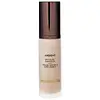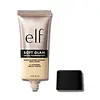What's inside
What's inside
 Key Ingredients
Key Ingredients

 Benefits
Benefits

 Concerns
Concerns

 Ingredients Side-by-side
Ingredients Side-by-side

Water
Skin ConditioningCyclopentasiloxane
EmollientCyclohexasiloxane
EmollientIsododecane
EmollientTrimethylsiloxysilicate
EmollientGlycerin
HumectantButylene Glycol
HumectantDimethicone
EmollientLauryl PEG-10 Tris(Trimethylsiloxy)Silylethyl Dimethicone
EmulsifyingPolymethylsilsesquioxane
1,2-Hexanediol
Skin ConditioningDisteardimonium Hectorite
StabilisingAcrylates/Polytrimethylsiloxymethacrylate Copolymer
Skin ConditioningMagnesium Sulfate
Sorbitan Sesquioleate
EmulsifyingDimethicone/Vinyl Dimethicone Crosspolymer
Skin ConditioningTriethoxycaprylylsilane
Dimethicone/PEG-10/15 Crosspolymer
Aluminum Hydroxide
EmollientTribehenin
EmollientCaprylyl Glycol
EmollientTocopheryl Acetate
AntioxidantEthylhexylglycerin
Skin ConditioningXanthan Gum
EmulsifyingCaesalpinia Spinosa Fruit Extract
Skin ProtectingDipropylene Glycol
HumectantSodium Citrate
BufferingKappaphycus Alvarezii Extract
Skin ConditioningTocopherol
AntioxidantCamellia Sinensis Leaf Extract
AntimicrobialCI 77891
Cosmetic ColorantIron Oxides
Water, Cyclopentasiloxane, Cyclohexasiloxane, Isododecane, Trimethylsiloxysilicate, Glycerin, Butylene Glycol, Dimethicone, Lauryl PEG-10 Tris(Trimethylsiloxy)Silylethyl Dimethicone, Polymethylsilsesquioxane, 1,2-Hexanediol, Disteardimonium Hectorite, Acrylates/Polytrimethylsiloxymethacrylate Copolymer, Magnesium Sulfate, Sorbitan Sesquioleate, Dimethicone/Vinyl Dimethicone Crosspolymer, Triethoxycaprylylsilane, Dimethicone/PEG-10/15 Crosspolymer, Aluminum Hydroxide, Tribehenin, Caprylyl Glycol, Tocopheryl Acetate, Ethylhexylglycerin, Xanthan Gum, Caesalpinia Spinosa Fruit Extract, Dipropylene Glycol, Sodium Citrate, Kappaphycus Alvarezii Extract, Tocopherol, Camellia Sinensis Leaf Extract, CI 77891, Iron Oxides
Water
Skin ConditioningIsododecane
EmollientGlycerin
HumectantCoco-Caprylate/Caprate
EmollientDimethicone
EmollientPropylene Glycol
HumectantCetyl PEG/PPG-10/1 Dimethicone
EmulsifyingC12-15 Alkyl Benzoate
AntimicrobialTridecyl Trimellitate
EmollientSorbitan Sesquioleate
EmulsifyingSilica
AbrasiveBoron Nitride
AbsorbentDimethicone/Vinyl Dimethicone Crosspolymer
Skin ConditioningMagnesium Stearate
Cosmetic ColorantMagnesium Sulfate
Phenoxyethanol
PreservativeDisteardimonium Hectorite
StabilisingPEG/PPG-15/15 Dimethicone
EmulsifyingTrimethylsiloxysilicate
EmollientDiisostearyl Malate
EmollientSilica Dimethyl Silylate
EmollientAluminum Hydroxide
EmollientTriethoxycaprylylsilane
Caprylyl Glycol
EmollientEthylhexylglycerin
Skin ConditioningErythritol
HumectantHibiscus Esculentus Fruit Extract
Skin ConditioningButylene Glycol
HumectantLycium Chinense Fruit Extract
AntioxidantPsidium Guajava Fruit Extract
AstringentVaccinium Angustifolium Fruit Extract
Skin ProtectingHydroxyacetophenone
AntioxidantCI 77891
Cosmetic ColorantCI 77492
Cosmetic ColorantCI 77491
Cosmetic ColorantCI 77499
Cosmetic ColorantWater, Isododecane, Glycerin, Coco-Caprylate/Caprate, Dimethicone, Propylene Glycol, Cetyl PEG/PPG-10/1 Dimethicone, C12-15 Alkyl Benzoate, Tridecyl Trimellitate, Sorbitan Sesquioleate, Silica, Boron Nitride, Dimethicone/Vinyl Dimethicone Crosspolymer, Magnesium Stearate, Magnesium Sulfate, Phenoxyethanol, Disteardimonium Hectorite, PEG/PPG-15/15 Dimethicone, Trimethylsiloxysilicate, Diisostearyl Malate, Silica Dimethyl Silylate, Aluminum Hydroxide, Triethoxycaprylylsilane, Caprylyl Glycol, Ethylhexylglycerin, Erythritol, Hibiscus Esculentus Fruit Extract, Butylene Glycol, Lycium Chinense Fruit Extract, Psidium Guajava Fruit Extract, Vaccinium Angustifolium Fruit Extract, Hydroxyacetophenone, CI 77891, CI 77492, CI 77491, CI 77499
 Reviews
Reviews

Ingredients Explained
These ingredients are found in both products.
Ingredients higher up in an ingredient list are typically present in a larger amount.
Aluminum Hydroxide is a form of aluminum. It can be naturally found in nature as the mineral gibbsite. In cosmetics, Aluminum Hydroxide is used as a colorant, pH adjuster, and absorbent.
As a colorant, Aluminum Hydroxide may add opacity, or reduce the transparency. Aluminum hydroxide is contains both basic and acidic properties.
According to manufacturers, this ingredient is an emollient and humectant. This means it helps hydrate the skin.
In medicine, this ingredient is used to help relieve heartburn and help heal ulcers.
There is currently no credible scientific evidence linking aluminum hydroxide in cosmetics to increased cancer risk.
Major health organizations allow the use of aluminum hydroxide in personal care products and have not flagged it as a carcinogenic risk at typical usage levels.
Learn more about Aluminum HydroxideButylene Glycol (or BG) is used within cosmetic products for a few different reasons:
Overall, Butylene Glycol is a safe and well-rounded ingredient that works well with other ingredients.
Though this ingredient works well with most skin types, some people with sensitive skin may experience a reaction such as allergic rashes, closed comedones, or itchiness.
Learn more about Butylene GlycolCaprylyl Glycol is a humectant and emollient, meaning it attracts and preserves moisture.
It is a common ingredient in many products, especially those designed to hydrate skin. The primary benefits are retaining moisture, skin softening, and promoting a healthy skin barrier.
Though Caprylyl Glycol is an alcohol derived from fatty acids, it is not the kind that can dry out skin.
This ingredient is also used as a preservative to extend the life of products. It has slight antimicrobial properties.
Learn more about Caprylyl GlycolCi 77891 is a white pigment from Titanium dioxide. It is naturally found in minerals such as rutile and ilmenite.
It's main function is to add a white color to cosmetics. It can also be mixed with other colors to create different shades.
Ci 77891 is commonly found in sunscreens due to its ability to block UV rays.
Learn more about CI 77891Dimethicone is a type of synthetic silicone created from natural materials such as quartz.
What it does:
Dimethicone comes in different viscosities:
Depending on the viscosity, dimethicone has different properties.
Ingredients lists don't always show which type is used, so we recommend reaching out to the brand if you have questions about the viscosity.
This ingredient is unlikely to cause irritation because it does not get absorbed into skin. However, people with silicone allergies should be careful about using this ingredient.
Note: Dimethicone may contribute to pilling. This is because it is not oil or water soluble, so pilling may occur when layered with products. When mixed with heavy oils in a formula, the outcome is also quite greasy.
Learn more about DimethiconeThis ingredient is a silicone used to improve the texture of products and absorb oil. It does not get absorbed into the skin.
Like other silicones, Dimethicone/Vinyl Dimethicone Crosspolymer helps condition the skin by creating a barrier. In this sense, it can act as an emollient and trap moisture in.
This ingredient is a type of elastomer.
Learn more about Dimethicone/Vinyl Dimethicone CrosspolymerDisteardimonium Hectorite comes from the clay mineral named hectorite. It is used to add thickness to a product.
It can also help stabilize a product by helping to disperse other ingredients.
Hectorite is a rare, white clay mineral.
Learn more about Disteardimonium HectoriteEthylhexylglycerin (we can't pronounce this either) is commonly used as a preservative and skin softener. It is derived from glyceryl.
You might see Ethylhexylglycerin often paired with other preservatives such as phenoxyethanol. Ethylhexylglycerin has been found to increase the effectiveness of these other preservatives.
Glycerin is already naturally found in your skin. It helps moisturize and protect your skin.
A study from 2016 found glycerin to be more effective as a humectant than AHAs and hyaluronic acid.
As a humectant, it helps the skin stay hydrated by pulling moisture to your skin. The low molecular weight of glycerin allows it to pull moisture into the deeper layers of your skin.
Hydrated skin improves your skin barrier; Your skin barrier helps protect against irritants and bacteria.
Glycerin has also been found to have antimicrobial and antiviral properties. Due to these properties, glycerin is often used in wound and burn treatments.
In cosmetics, glycerin is usually derived from plants such as soybean or palm. However, it can also be sourced from animals, such as tallow or animal fat.
This ingredient is organic, colorless, odorless, and non-toxic.
Glycerin is the name for this ingredient in American English. British English uses Glycerol/Glycerine.
Learn more about GlycerinIsododecane is a fragrance, emollient, and solvent.
As an emollient, it helps your skin stay soft and hydrated. Emollients help trap moisture into your skin.
Isododecane's role as a solvent makes it a great texture enhancer. It spreads smoothly on skin and does not leave a sticky feeling behind. Isododecane also helps prevent color transfer in makeup products.
Isododecane is not absorbed into skin.
Learn more about IsododecaneMagnesium Sulfate is a salt. More specifically, it is an epsom salt, or the bath salt used to help relieve muscle aches.
Despite having ‘sulfate’ in the name, it isn’t a surfactant or cleansing agent like sodium lauryl sulfate. Unlike those sulfates, magnesium sulfate doesn’t have the same cleansing or foaming properties (it's simply a type of salt).
In cosmetics, Magnesium Sulfate is used to thicken a product or help dilute other solids. It is a non-reactive and non-irritating ingredient.
One study shows magnesium deficiency may lead to inflammation of the skin. Applying magnesium topically may help reduce inflammation.
You can find this ingredient in sea water or mineral deposits.
Learn more about Magnesium SulfateSorbitan Sesquioleate is derived from sorbitol and oleic acid. It is an emulsifier and prevents ingredients from separating.
Specifically, this ingredient is a water-in-oil emulsifier, meaning it helps water dissolve into oil.
Some studies suggest this ingredient may cause irritation in some people. If you are unsure, it is best to patch test.
This ingredient may not be Malassezia folliculitis, or fungal-acne safe.
Learn more about Sorbitan SesquioleateTriethoxycaprylylsilane is a silicone used to bind and stabilize ingredients.
As an emulsifier, it helps prevent ingredients from separating. This can help elongate the shelf life of products.
Triethoxycaprylylsilane is often used to coat mineral sunscreens ingredients to help give a better feel. It also helps reduce oxidative stress in sunscreens.
Learn more about TriethoxycaprylylsilaneThis silicone is an emollient. Emollients create a thin film on the skin to prevent moisture from escaping.
It is not soluble in water and helps increase water-resistance in products.
According to a manufacturer, it can blend seamlessly with silicone oils, such as Cyclopentasiloxane.
Learn more about TrimethylsiloxysilicateWater. It's the most common cosmetic ingredient of all. You'll usually see it at the top of ingredient lists, meaning that it makes up the largest part of the product.
So why is it so popular? Water most often acts as a solvent - this means that it helps dissolve other ingredients into the formulation.
You'll also recognize water as that liquid we all need to stay alive. If you see this, drink a glass of water. Stay hydrated!
Learn more about Water